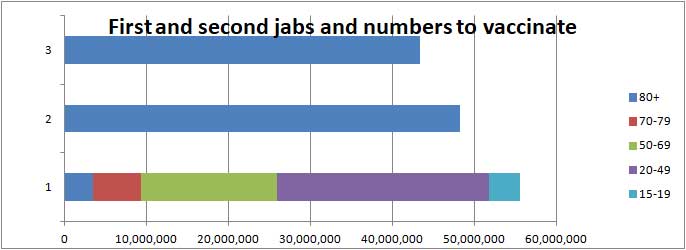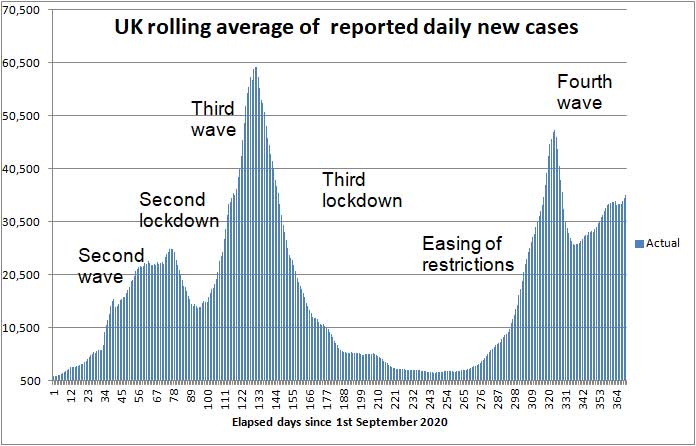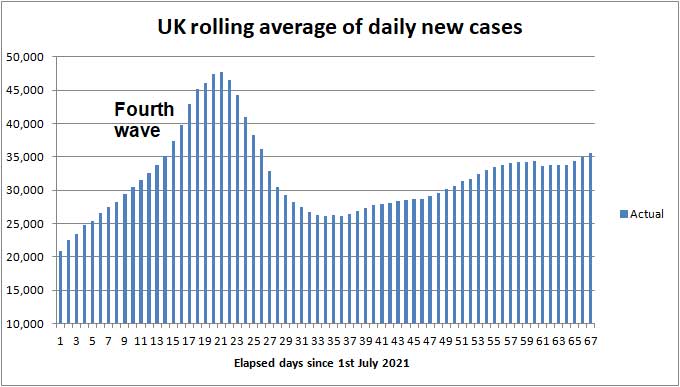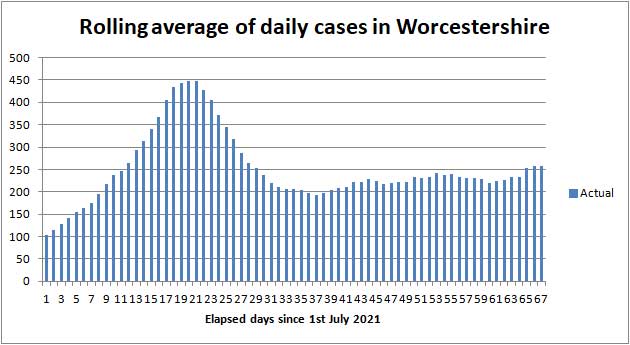
Angus and Rosemary's Miscellany
of Malvern - Other Resources
|
Coronavirus (COVID-19) epidemic weekly update for Malvern Seniors5th September 2021 DAILY CASES FLAT-LINING Take care as virus widespread
Skip to menu of archived pages PreambleWe keep an eye on the published government figures and monitor the media to asses the level of risk for Seniors in the Malvern Hills district. This page is normally updated every Sunday between 1800 and 2400 hours GMT. Information about Coronavirus can be found on the NHS website: https://www.nhs.uk/coronavirus How to get vaccinatedThe most important thing people can do now is get vaccinated. Most Seniors should have been double jabbed by now, but if not get your vaccine, and encourage your friends and loved ones to get theirs. The effectiveness of the vaccines falls over time so get your booster shot when the time comes. During August first vaccinations can be obtained at the Three Counties Show Ground without an appointment. Monday to Friday 8.00am to 5.00pm Saturday 8.00am to 1.30pm (AstraZeneca and Moderna vaccinations available) Use Brown Gate entrance, postcode WR13 6NW
|
| Districts of Worcs | Cases | Weekly increase | Population |
| Bromsgrove | 10,314 | +418 | 98,529 |
| Malvern Hills | 4,733 | +185 | 77,545 |
| Redditch | 8,978 | +277 | 85,317 |
| Worcester | 9,864 | +265 | 103,542 |
| Wychavon | 9,711 | +293 | 126,240 |
| Wyre Forest | 8,672 | +373 | 100,957 |
| TOTAL | 52,272 | +1,811 | 592,130 |
| COMPARE WITH | |||
| County of Hereford | 11,674 | +593 | 195,000 |
| Leicester (city of) | 51,718 | +1,328 | 400,000 |
Cumulative cases reported by PHE in Worcestershire to 5th September 2021
Apart from Worcester and Leicester the increase is larger this week.
Note: the weekly increase is indicative; the seven day average by area, which varies day to day, is an alternative metric that can be found on the Coronavirus dashboard.
Interactive map
At the bottom of the Coronavirus Dashboard (daily update) page there is an Interactive Map which is coloured to show infection rates across the country. This week the map shows much of the UK has turned dark blue indicating high infection rates, with increasing patches of purple indicating very high rates particularly in Cornwall, Scotland and Northern Ireland.
Click for Interactive Map of COVID cases
Note: the Interactive Map works on desktop PCs but it's possible you may encounter difficulties using a tablet or smartphone.
Recent weekly cases to 31st August are: North Malvern 22; Malvern Link 18; Pickersleigh 19; Barnards Green 15; Malvern Wells and Priory 19; Callow End and Hanley 11; Upton and Welland 11.
Number of deaths
Statistics on COVID deaths are published by Public Health England, The Office of National Statistics, and NHS England.
PHE figures
Public Health England reports that the cumulative total of COVID (28) deaths in UK hospitals and care homes has risen by 792 in the last week to 133,229 while the daily average flat-lined at 114 deaths per day.
Note: the 'dip' in the chart at the start of this week was caused by delayed reporting of deaths over the autumn Bank Holiday.
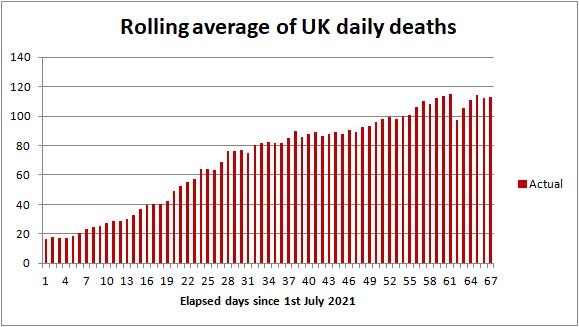
COVID-19 death rate 1st July to 5th September 2021
Click to view the UK government Coronavirus Dashboard
In comparison averaged over recent years 1,700 people die daily from all causes, so COVID deaths have risen to 7%.
The death rate remains higher than might have been expected given the number of cases but no official explanation has been offered.
ONS figures
The Office of National Statistics (ONS) separately reports registered deaths in England and Wales where COVID-19 is mentioned on the death certificate. The ONS figures lag the PHE figures by 10 - 14 days and do not include Northern Ireland and Scotland.
Click for national ONS data on deaths (Excel spreadsheet)
The ONS figures are broken down by District providing a glimpse of where deaths are occurring. The provisional cumulative total of COVID related deaths in Worcestershire reported by the ONS up to 20th August 2021 (week 33 of 2021) is shown below.
Note: the numbers are from the ONS Death Registrations-Pivot table
| Districts of Worcs | Deaths 2020 |
Deaths 2021 |
Week 33 | Population |
| Bromsgrove | 164 | 107 | 0 | 98,529 |
| Malvern Hills | 61 | 83 | 0 | 77,545 |
| Redditch | 108 | 88 | 3 | 85,317 |
| Worcester | 87 | 121 | 3 | 103,542 |
| Wychavon | 157 | 125 | 2 | 126,240 |
| Wyre Forest | 171 | 112 | 4 | 100,957 |
| TOTAL | 748 | 637 | 12 | 592,130 |
Provisional cumulative COVID-19 deaths registered by ONS to 20th August 2021
In week 33 there were no COVID deaths in the Malvern Hills, but elsewhere in Worcestershire there were 12, double the week before: 3 deaths in hospital in Redditch; 1 death at home and 2 deaths in hospital in Worcester; 2 deaths in hospital in Wychavon; 2 deaths in care homes plus 2 in hospital in Wyre Forest (Kidderminster).
In England and Wales 569 COVID-19 related deaths were reported in the week to 20th August, the same as the week before. Of these 29 were in a care home, 45 at home, 4 in a hospice, 485 in hospital and 6 elsewhere.
Note: summation of rows 9 to 339 of the ONS deaths Registrations-Pivot table.
The provisional UK COVID-19 death toll (as reported by PHE and ONS) for all weeks of the epidemic can be found on the Deaths tab of the Coronavirus Dashboard.
NHS England figures
The table below shows latest COVID deaths in Worcestershire hospitals reported by NHS England to 3rd September 2021.
| Worcestershire | Cumulative deaths | Past week |
| Acute hospitals | 834 | 9 |
| Care hospitals | 63 | 0 |
| TOTAL | 897 | 9 |
Click for NHS COVID-19 total announced deaths
Up from 6 reported last week.
Note: Statistics can also be found on the Healthcare tab of the UK Coronavirus Dashboard. At the top of the page where it says Healthcare in United Kingdom, click the drop down arrow to select Area Type as NHS Trusts, and Area Name as Worcester Acute Hospitals.
Risk of COVID-19 death by age band
NHS England provides an analysis of COVID-19 deaths in hospital in England and Wales by age band. Shown below is a breakdown of deaths for the period 1st June 2021 to 15th August 2021 when, despite much of the population being protected by the vaccines, the death rate rose to 90 deaths per day.
| Age band | Number of deaths | % of deaths |
| 0 - 19 | 7 | 0.3 |
| 20 - 39 | 67 | 3 |
| 40 - 59 | 300 | 14 |
| 60 - 79 | 862 | 42 |
| 80+ | 834 | 40 |
Risk of COVID-19 death by age band
So far the government has not provided a quantitative analysis by vaccination status, but one might expect the majority of deaths to be of the vaccine hesitant, those with underlying conditions such as Diabetes, and those that are immuno-compromised.
Those aged 60+ years now account for 82% of deaths compared to 92% last year but remember that, due to vaccination, the death rate as a proportion of new cases is roughly ten times lower than in 2020.
The infection rate in England is currently 320 in 100,000 per week so even if this continued all year the chance of catching COVID would be no more than 1 in 7.
A few weeks ago the probability of dying of COVID had been about 1 in 500 of those that test COVID positive (see below) and as most deaths are amongst the elderly the chance of fully vaccinated Seniors dying of COVID could be about 1 in 1,000 of those infected, and the probability of dying of COVID in any one year no more than 1 in 10,000. With the vaccines reducing in effectiveness as months go by the odds could worsen towards 1 in 1,000.
These odds are unlikely to worry fully vaccinated healthy and optimistic Seniors wanting to make the most of their remaining years.
On the other hand the risk-averse might be cautious bearing in mind that the vaccine does not work for about one person in twenty, for example the immuno-suppressed.
There has been only one COVID death in the Malvern Hills in recent weeks.
Healthcare numbers
The UK government Coronavirus Dashboard includes important information about healthcare statistics.
| Hospital COVID cases (UK) | Number | Change since last week |
| Patients currently in hospital | 7,541 | +599 |
| Patients on ventilation | 1,038 | + 56 |
| Patients admitted daily | 985 | + 16 |
Headline summary of patients in hospital as reported 5th September 2021
NOTES
Daily hospital admissions which are rising very slowly look set to reach 1,000 next week.
The number of patients on ventilation is now 25% of the peak in January 2021 which seems rather high. An explanation is needed for this and the increasing death rate.
There are currently few signs of extreme pressure being put on most hospitals despite bed occupancy continuing to creep up nationally.
As a guide from observing peaks in the charts a few weeks ago it looked as though roughly:-
-
1 in 50 of new of cases are hospitalised 8 days after testing positive.
-
1 in 500 of new cases die on average 20 days after being tested positive.
These ratios depend on the percentage of infected individuals coming forward to be tested, the proportion of young people in the mix, and the effectiveness of the vaccines all of which will vary over time. Recent data suggests more pessimistic ratios of 1:35 and 1:350. On 13th September the ONS plans to publish an analysis of deaths by vaccination status for the period 1st Jan - 2nd July 2021 which may shed light on how well the vaccines are protecting us.
 Worcestershire hospital beds
Worcestershire hospital beds
Tabulated figures for bed occupancy in Worcestershire Acute and Care hospitals can be found on the NHS England website.
Click for NHS England COVID-19 Hospital bed Activity
An easy to read summary can be found on the Worcestershire Coronavirus Dashboard.
Click to view Worcestershire Coronavirus Dashboard.
There are now 34 COVID-19 patients occupying Worcestershire Acute Hospital beds, of which 2 are ventilated beds; roughly 13% of the peak experienced last January.
Click for Simple Summary of Malvern numbers on the Coronavirus dashboard
Forecast for the week ahead
Trends suggest that during the next seven days (up to 12th September) the cumulative total of UK COVID-19 cases reported by PHE on the Coronavirus Dashboard could increase by 250,000 towards 7,234,000 while the 7 day rolling average of daily new cases could rise from 35,596 to somewhere between 36,000 and 39,000 new cases per day.
In Worcestershire about 1,800 new cases of COVID-19 can be expected, and 200 cases in the Malvern Hills district.
We estimate the number of UK COVID (28) deaths will increase by about 810 towards 134,000 during the 7 days ending 12th September 2021, with the average daily death rate possibly rising from 114 towards 125 depending on the ages of those affected.
In the county of Worcestershire, assuming a 0.3% death rate, the 1,811 new cases this week ought to translate to about 6 COVID deaths per week in the middle of September.
Longer term outlook
We found a new source of figures from University College London for you to dip into:-
Click for UCL Long-term forecasting of the COVID-19 epidemic
New daily cases, hospital admissions and the death rate have remained fairly flat over the last fortnight but there are signs of a rise after the autumn Bank Holiday. Daily cases could increase further after pupils go back to schools next week and students return to university; then as more time is spent indoors during the winter. How high daily cases go is impossible to say but perhaps it won't be much above the present level.
Hospital admissions, cases of Long COVID and deaths can be expected to follow daily cases very roughly in the ratio:
Hospital admissions 1:35 of daily cases reported by PHE, lagging by 8 days.
Long COVID 1:35 of daily cases reported by PHE, continuing for 3 months or more.
Deaths 1:350 of daily cases reported by PHE, lagging by about 20 days.
The government could be forced either to issue guidance or re-impose some restrictions (but not a lockdown) were the number of UK hospital beds occupied by COVID patients to reach 10,000. The COVID-19 Alert Level was lowered to 3 on 10th May 2021 and since then the number of cases has risen steeply from 2,000 to 35,000 cases per day. Consequently the COVID-19 Alert Level could be raised back to 4 should pressure on hospitals grow throughout September. However with a bit of luck this may be avoided.
Click for guidance on UK COVID-19 alert level methodology: an overview
Click for COVID-19 Alert Level lowered to 3 on 10th May 2021
Hospital bed occupancy currently approximates to one quarter of daily cases.
Ignoring the spike in daily cases in the middle of July caused by football supporters, it could be we are not far from the peak of a broad exit wave; however one or more 'bumps in the road' during the autumn and winter cannot be ruled out.
Scientists have said that it is impossible to predict when the EXIT wave will peak and that will probably not be known for sure until at least three weeks after the peak is past.
There was concern that cases had been rising steeply in Israel where the population was the first to be vaccinated, but there are rumours that third jabs may be bringing the situation under control.
HMG seems to be of the view that, now we have the vaccines, life must return to normal despite an increasing number of mostly elderly casualties. Let's hope we are near the peak and the COVID-19 death rate is not going to worsen.
We'll just have to wait and see how things pan out during the autumn and winter and adjust our behaviour accordingly. Fingers crossed we are through the worst.
Mutations of the virus are constantly evolving around the world and the scenario could change in the unlikely event a more deadly variant of COVID-19 entered the UK escaping the vaccines.
Advice for Seniors
 Currently
there are no more than 12 COVID related deaths per week in Worcestershire
which has a population of 600,000 so we judge the
risk of death for fully vaccinated
Seniors to be
fairly
LOW while the risk of Long COVID might be MODERATE;
see our annex and riskometer opposite.
Currently
there are no more than 12 COVID related deaths per week in Worcestershire
which has a population of 600,000 so we judge the
risk of death for fully vaccinated
Seniors to be
fairly
LOW while the risk of Long COVID might be MODERATE;
see our annex and riskometer opposite.
Remember, if you are elderly, have not been vaccinated, and were to catch COVID there is a significant chance that you will either die or your long term health may be seriously damaged, so if you are able get both doses of your vaccine and continue to take care of yourself and those you love. Also encourage others to be vaccinated.
Click for our risk of death table (for those who have not been vaccinated)
Like Sajid Javid, it is quite possible, despite a second jab, for Seniors to become ill with COVID-19; some might have mild symptoms like a common cold or hay fever, while others could feel very poorly, but few except the frail and vulnerable will need to be admitted to hospital.
Until daily cases fall markedly the simple safeguards to remember are to:
-
wash your HANDS thoroughly, using soap and hot water, for 20 seconds, including after handling deliveries to your home, to kill virus picked up from contaminated surfaces see note 1;
-
wear a FACE covering when unavoidably near other people for example when shopping, visiting hospital or the chemist, and using public transport;
-
SPACE at least 2 metres from people you don't feel safe with see note 2;
-
preferably socialise with friends and other households outdoors in the FRESH AIR else, if you can, keep doors and windows open if you are indoors;
-
minimise TIME near strangers;
-
look out for symptoms and self-isolate and book a test if you feel unwell; according to the Zoe COVID Study the top five symptoms amongst the fully vaccinated in order of prevalence are said to be runny nose (75%), headache (73%), sneezing (67%), sore throat (53%), and loss of smell (51%);
-
avoid indoor settings, crowds, mass events, and areas where the infection rate is likely to be high;
-
respect others and give them space.
Notes:
1) Wash your hands thoroughly before touching your face to avoid transferring virus from contaminated surfaces to your mouth, eyes and nose. If outdoors use hand gel.
2) Two metres is further than you think - roughly an arm and a walking stick away.
Annex to 5th September update
Commentary
During the last fortnight the average number of UK daily cases and deaths has roughly flat-lined. In Worcestershire cases dipped slightly but are now rising albeit at a slow rate.
It seems likely that COVID-19 will become endemic in the UK and we wonder what the residual number of new daily cases, hospital admissions, and deaths will eventually be. Are we already close to that level or can we expect cases to drop to a much lower level? If you have modelled the spread of COVID-19 do please tell us what you think.
On Wednesday, in Scotland, where cases have risen steeply in recent days, it was announced Vaccine Passports could become a condition of entry to nightclubs.
Click for BBC report Covid in Scotland: Vaccine passport benefits 'outweigh concerns'
Third jabs of primary vaccine are to offered to about 500,000 patients with weakened immune systems.
Click for BBC report Third Covid jab advised for most vulnerable 1%
On Thursday King's College reported that fully vaccinated individuals were half as likely to suffer from Long COVID. Another commentator speaking on the radio suggested one third of ventilated patients died, and someone spoke about a loved one who died unknowingly having a very low oxygen level in their blood. That reminded us that Oximeters can be used to check oxygen levels at home.
On Friday the JCVI reported there was little medical benefit in vaccinating healthy 12 - 15 year olds. The issue has now been passed to the Chief Medical Officers to consider wider factors such as the disruption of education.
The matter of booster jabs for healthy Seniors is still being studied and the JCVI has yet to report. Questions being asked include when would be the optimum time to give the booster jab, and what vaccine should be used.
On Sunday, Nadhim Zahawi, the Vaccines Minister, appearing on the Andrew Marr show, said that vaccine passports would be required for nightclubs, mass events and large venues in England by the end of this month. By that time all those aged 18+ will have been offered a second jab.
An announcement about booster vaccinations for those aged 50+ years will be made once trials to evaluate the best vaccine to use are complete. Jabs are expected to be rolled out starting with the most elderly from mid September.
Nadhim Zahawi insisted the government has yet to decide whether or not to vaccinate healthy 12 to 15-year-olds against COVID and is waiting for advice from Chief Medical Officers.
U3A meetings resume
The new session starts in September starting with the Groups Fair at Malvern Theatres on 6th September. Many members will be happy to attend meetings in person but some may be more cautious.
As far as we are aware Malvern U3A has not so far published a COVID-19 Plan for circulation to members, but it is suggested:
-
Members who are feeling poorly should not attend U3A meetings in person.
-
Members who feel poorly after a meeting should take a test and if positive report the incident to their group leader. Group leaders should in turn warn those who attended the meeting.
Other weekly updates
Here are links to the weekly Zoe COVID Study and Independent SAGE updates:-
Click to watch Tim Spector's Zoe COVID Study 2nd September update
In brief, cases have been slowly rising to an estimated 57,000 cases per day; the fully vaccinated make up about 30% of new cases and that is likely to increase as more people are vaccinated. The chance of meeting someone with COVID is currently about 1 in 90 many of whom will have been double vaccinated. Cases are high in under 30s in Scotland following night clubs and schools reopening.
Long COVID is estimated 949 new cases every day, mostly in younger people.
Reasons for high levels of COVID are the lifting of restrictions, few wearing face masks, effectiveness of vaccines waning, and increasing complacency. The government is not advertising the latest top five symptoms - runny nose, headache, sneezing, sore throat, and loss of smell.
Possibly 40% of COVID cases are being missed because the fully vaccinated and children are not showing the classic symptoms listed on the 'outdated' government website.
Outdoor mass events such as music festivals may not be safe where people are packed close together, travel en mass, and share toilets etc.
Prof Tim Spector recommends enjoying life and acting sensibly while avoiding mass gatherings and crowded places.
The Independent SAGE weekly briefing of 3rd September discusses the safety of children returning to school:-
Click to watch Independent SAGE 3rd September briefing
Proposed measures include improved ventilation, the wearing of masks, and the vaccination of pupils aged 12+ years.
Click for Independent SAGE plan for safer schools
Overseas travel
Deleted - please refer to gov.uk and the BBC for advice.
List of vaccines
Here is the list of vaccines ordered by the UK. Plenty of vaccine is on order for delivery later in 2021 for booster jabs and vaccinating those aged 12 - 18 years.
| COVID-19 vaccine | Doses ordered (million) | Status |
| Pfizer BioNTech, two dose, -70 deg C | 40+60+35 | Approved, deliveries continuing, made in Belgium (EU). An additional 60M doses have been ordered for booster shots for the most vulnerable in the autumn. A further 35M doses were ordered in August 2021 for delivery in 2022. |
| Astrazeneca, two dose, fridge | 100 | Approved for those aged 30+ years; deliveries continuing. Batches made in UK, Belgium and India. |
| Moderna, two dose, -20 deg C | 7+10 | Approved. First deliveries to Wales and Scotland 7th April 2021 then England 13th April; mainly for those aged under 50 years awaiting vaccination. |
| Valneva, two dose | 60+40 | A jab from French company Valneva will be made in Livingston, West Lothian, Scotland. Delivery to start in second half of 2021. |
| Janssen, single dose | 20 | Approved, a jab from Belgian firm Janssen, owned by Johnson and Johnson; UK approval 28th May. Order reduced from 30 to 20M. |
| Novavax | 60 | A jab manufactured by US firm Novavax is being made in Stockton-on-Tees UK; phase III trials complete, awaiting approval. Should be available later this year. Glaxo Smith Kline (GSK) has been contracted to fill and package vials. |
| GSK Sanofi | 60 | Some delay due to adjusting the formula to give better protection to the elderly; expect approval end 2021. |
| Curevac | 50 | Contract placed with German company Feb 2021. Possible source of new variant vaccine later in 2021 |
Table of vaccines ordered by the UK government
Present rate of new cases and risk
Figures are broadly the same as last week. The average rate of infection per 100,000 population per week in England is 303 while in comparison the figure for Worcestershire is now 277 and the Malvern Hills 240.
As a yardstick we suggest a figure of below 10 can be considered LOW.
The probability of fully vaccinated Seniors without underlying conditions catching and dying from COVID-19 is now possibly somewhere in the range 1 in 1,000 to 1 in 10,000 per year so we judge the risk fairly LOW. Perhaps as many as 3% to 5% of people who catch COVID suffer from Long COVID so that risk might be assessed MODERATE. A member of the family had Long COVID and it was very debilitating.
The risk of death from Coronavirus for unvaccinated children and healthy teenagers is said to be small so for them the risk is LOW. There had been concern about youngsters suffering from Long COVID but a recent report by King's College London concludes most children do not suffer acute illness and this is not a 'major' issue.
Click for report - Long COVID uncommon in children, analysis finds
About the UK COVID-19 final death toll
The UK is going to have to live with COVID-19 and a background level of infection which could increase every winter as more time is spent indoors. Barring new variants, this may result in many thousands of COVID deaths per year, as with flu. So in that respect there can be no 'final' death toll.
The present 2020/2021 death toll will likely climb from 133,000 towards 145,000 by Christmas 2021 based on the PHE definition of deaths. If ONS figures are used the UK toll could be heading towards 200,000.
Worldwide, this pandemic is not played out and it could be a further 2 to 3 years before the 'dust' finally settles and third world countries are vaccinated. The PM has promised an independent inquiry in Spring 2022 to learn lessons for the future.
At the start of the epidemic on 17th March 2020 the Chief Scientific Adviser, Sir Patrick Valance, questioned by the Health Select Committee, did not disagree with Jeremy Hunt's suggestion that a death toll of 20,000 might be a reasonable outcome.
On the other hand, Professor Neil Ferguson of Imperial College warned in some scenarios the death toll might be as high as 250,000; while we thought, in the very worst case assuming up to 1% of the UK population died the outcome might have been nearer 400,000 taking into account some build up of herd immunity.
So how well will the UK have done? When Jeremy Hunt and Sir Patrick Valance spoke there had been few deaths and they clearly underestimated what was to come. Professor Neil Ferguson was nearest the mark. A few might consider an outcome of about 145,000 deaths during 2020 and 2021 a fair result compared to a greater number of people dying in a very short space of time, more being permanently disabled by Long COVID, temporary collapse of the NHS and patients dying at home or queued in ambulances outside hospitals. You have only to look at the recent situation in India to imagine what could have happened.
Members of the Labour Party and others will no doubt say the UK has done poorly compared to the best performing countries such as New Zealand and Singapore where deaths have been much lower, not to mention the enormous expense of supporting those out of work and huge damage to the economy. Bear in mind the situation in New Zealand has not played out. NZ has been slow to vaccinate and it has yet to be seen whether their border controls will stop the spread of the Delta variant.
With hindsight, deaths might have been much lower if the second lockdown had been continued into December and January, but that would have meant cancelling Christmas, and who knows to what extent the public would have complied.
A member of the marketing team at US company 'My Bio Source' sent us a link to a History of Pandemics. Let's hope our brilliant scientists can continue to protect us from future threats.
Summary of Links
Symptoms
Article about the effects of Coronavirus on the human body
Reporting and how to obtain a test
How to get a test
https://www.nhs.uk/coronavirus
About joining the Zoe COVID Symptom Study:
Guidance
UK government Coronavirus guidance
COVID Alert states
Guidance on UK COVID-19 alert level methodology: an overview
COVID-19 Alert Level lowered to 3 on 10th May 2021
Tiers
Guidance on tiers: what you need to know
Government postcode checker to find tier for other areas
Statistics
UK government Coronavirus Dashboard
Coronavirus Dashboard Interactive Map
ONS data on deaths in England and Wales (Excel spreadsheet)
NHS England COVID-19 Daily Deaths
NHS England COVID-19 Hospital Admissions
NHS England vaccination statistics
Worcestershire Coronavirus Dashboard
Worcestershire COVID-19 Vaccinations Dashboard
A glimpse of the worldwide vaccination situation can be found on the Our World in Data website.
Click for chart showing % vaccinated
Modelling
A forecast of the progression of the COVID-19 epidemic can be found on a University College London (UCL) website.
Click for UCL Long-term forecasting of the COVID-19 epidemic
A projection of the future COVID-19 death toll and daily deaths can be found on The Institute for Health Metrics and Evaluation website.
Click for IHME projection of COVID-19 deaths
Reports
ONS Coronavirus (COVID-19) Roundup
The bigger picture
Worldometer summary of coronavirus cases worldwide
European Centre for Disease Prevention and Control info
https://www.ecdc.europa.eu/en/geographical-distribution-2019-ncov-cases
World Health Organisation info
Window on the USA
Centre for Disease Control (CDC)
American Association of Retired People (AARP)
Worcestershire
Help:
http://www.worcestershire.gov.uk/here2help
Worcestershire County Council COVID-19 information:
http://www.worcestershire.gov.uk/coronavirus
Here you will find a useful link,
'Website: Number of new cases by date in Worcestershire'
which displays interesting COVID charts and statistics for Worcestershire
Miscellaneous
Spanish Flu
Dr Jeff Kildea's commentary about the 1919 outbreak of Spanish Flu in Australia
Views of Martin McKee, Professor of European Public Health
Follow Martin McKee on Twitter
SAGE membership
Scientific Advisory Group for Emergencies (SAGE)
Scottish government:
Link to Scottish Government website
Link to Postcode checker for COVID restrictions by protection level in areas of Scotland
Welsh Government:
Guidance on COVID alert levels in Wales

The interpretations and opinions expressed are our own
Last updated 6th September 2021
 Blogs
>
Blogs
>
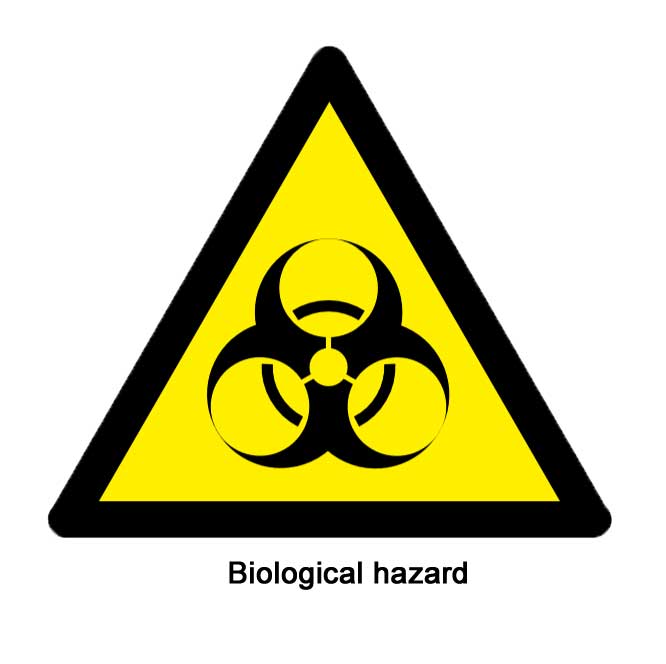 How
to request a COVID test
How
to request a COVID test You
can also collect home test kits,
packaged as the COVID-19 Self-Test (Rapid Antigen Test) in boxes of 7 tests,
from the library and most pharmacies such as Boots and Murrays in Church
Street, Claremont House and Lloyds in Barnards Green, Murrays at Prospect
View, Evans and Murrays in Malvern Link, and Boots and Morrisons on the
Enigma Retail Park. (Lateral Flow Device shown on the right).
You
can also collect home test kits,
packaged as the COVID-19 Self-Test (Rapid Antigen Test) in boxes of 7 tests,
from the library and most pharmacies such as Boots and Murrays in Church
Street, Claremont House and Lloyds in Barnards Green, Murrays at Prospect
View, Evans and Murrays in Malvern Link, and Boots and Morrisons on the
Enigma Retail Park. (Lateral Flow Device shown on the right).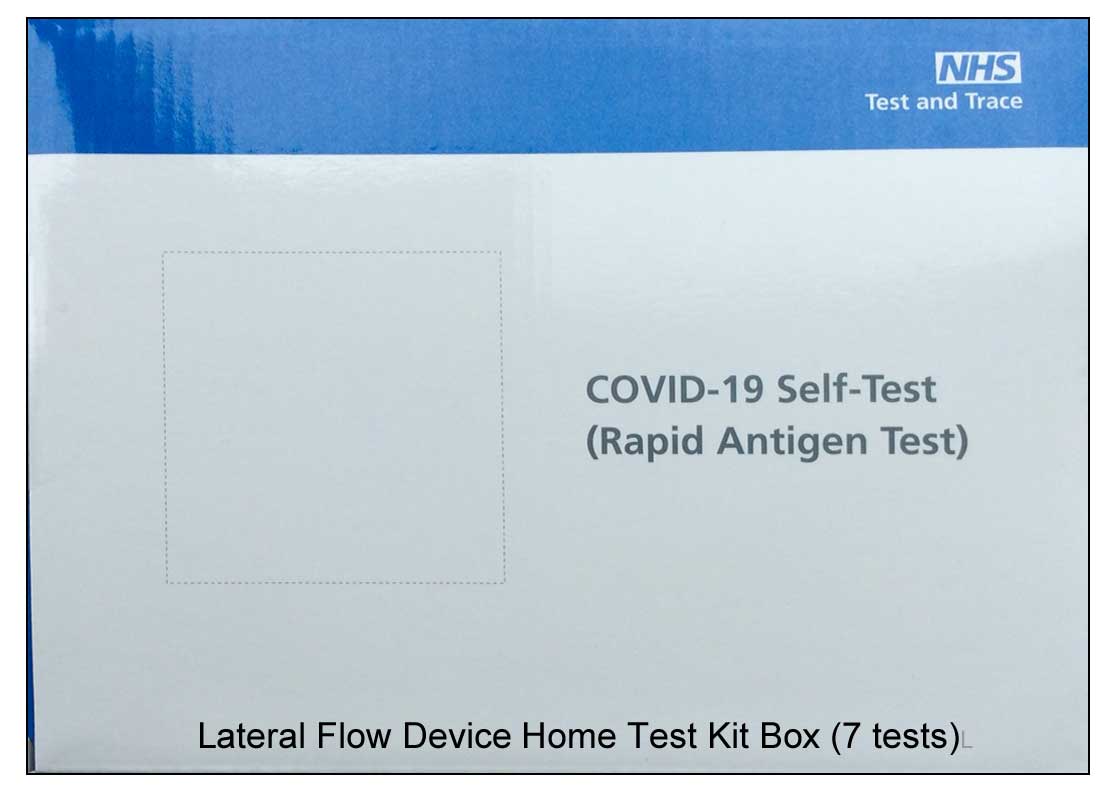
 You
can help others by downloading the COVID Symptom Study app onto your
smart phone or Ipad and reporting how you feel either daily, or as you are
able. Note there is no desktop PC version for Windows.
You
can help others by downloading the COVID Symptom Study app onto your
smart phone or Ipad and reporting how you feel either daily, or as you are
able. Note there is no desktop PC version for Windows.